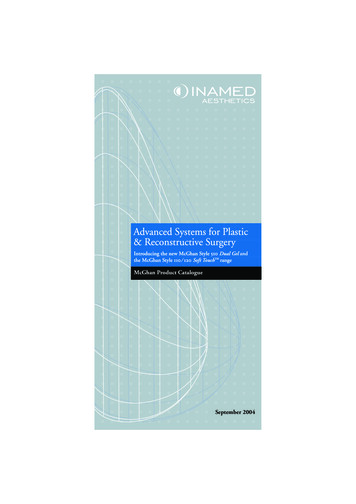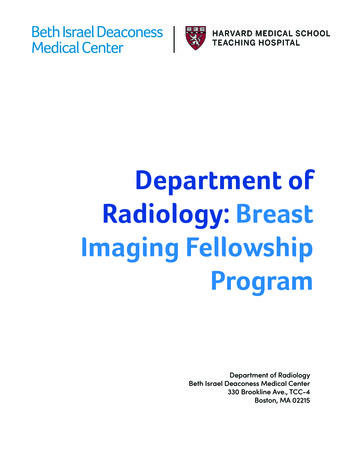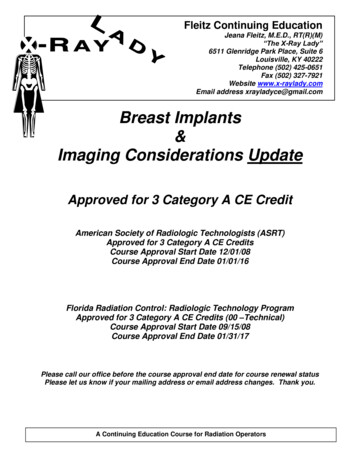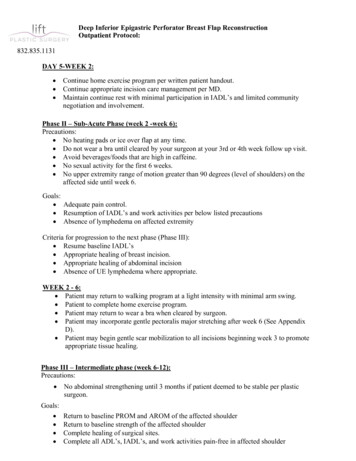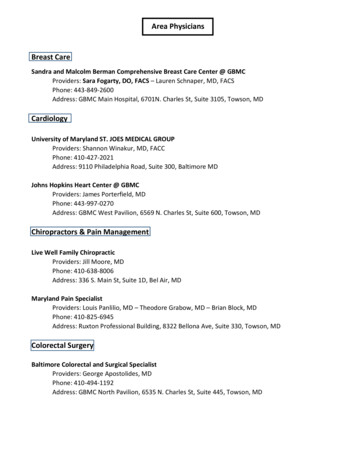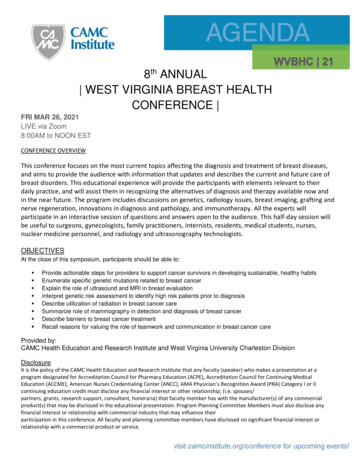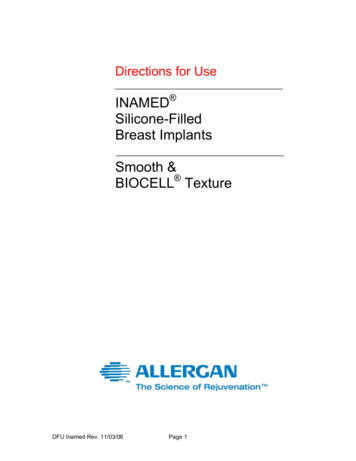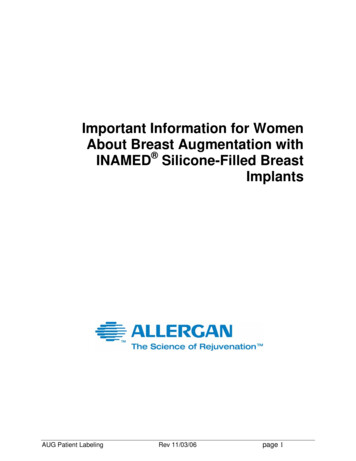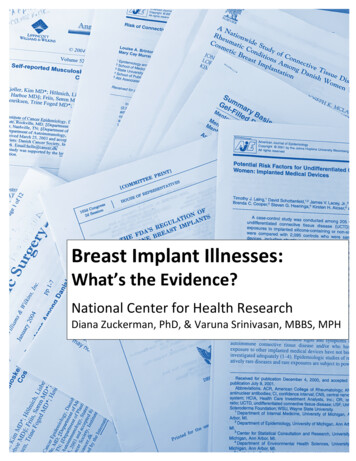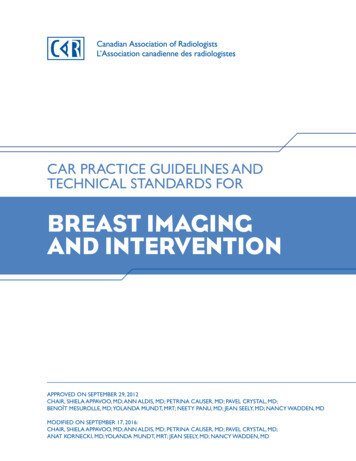
Transcription
CAR PRACTICE GUIDELINES ANDTECHNICAL STANDARDS FORBREAST IMAGINGAND INTERVENTIONAPPROVED ON SEPTEMBER 29, 2012CHAIR, SHIELA APPAVOO, MD; ANN ALDIS, MD; PETRINA CAUSER, MD; PAVEL CRYSTAL, MD;BENOÎT MESUROLLE, MD;YOLANDA MUNDT, MRT; NEETY PANU, MD; JEAN SEELY, MD; NANCY WADDEN, MDMODIFIED ON SEPTEMBER 17, 2016:CHAIR, SHIELA APPAVOO, MD; ANN ALDIS, MD; PETRINA CAUSER, MD; PAVEL CRYSTAL, MD;ANAT KORNECKI, MD;YOLANDA MUNDT, MRT; JEAN SEELY, MD; NANCY WADDEN, MD
The practice guidelines of the Canadian Association of Radiologists (CAR) are not rules, butare guidelines that attempt to define principles of practice that should generally produceradiological care. The radiologist and medical physicist may modify an existingpractice guideline as determined by the individual patient and available resources.Adherence to CAR practice guidelines will not assure a successful outcome in everysituation. The practice guidelines should not be deemed inclusive of all proper methods ofcare or exclusive of other methods of care reasonably directed to obtaining the sameresults. The practice guidelines are not intended to establish a legal standard of care orconduct, and deviation from a practice guideline does not, in and of itself, indicate orimply that such medical practice is below an acceptable level of care. The ultimatejudgment regarding the propriety of any specific procedure or course of conduct mustbe made by the physician and medical physicist in light of all circumstances presentedby the individual situation.Approved on September 29, 2012Chair, Shiela Appavoo, MD; Ann Aldis, MD; Petrina Causer, MD; Pavel Crystal, MD;Benoît Mesurolle, MD; Yolanda Mundt, MRT; Neety Panu, MD; Jean Seely, MD; Nancy Wadden, MDModified On September 17, 2016:Chair, Shiela Appavoo, MD; Ann Aldis, MD; Petrina Causer, MD; Pavel Crystal, MD;Anat Kornecki, MD; Yolanda Mundt, MRT; Jean Seely, MD; Nancy Wadden, MDii
TABLE OF CONTENTSPreamble . 3Section A: Breast Imaging. 41. Mammography. 41.1. Screening Mammography. 4Definition. 4Indications. 4Self referral. 5 Qualifications and Responsibilities of Personnel. 5Equipment. 6Specifications of the Examination. 7The Screening Mammography Report. 8Quality Control. 9Quality Assurance. 91.2. Diagnostic Mammography and Problem Solving Breast Evaluation.10Definition.10Goal.10Indications.10 Qualifications and Responsibilities of Personnel.10Equipment.10Specifications of the Examination.11The Diagnostic Report.11 Double Reading and Computer Assisted Detection (CAD).111.3 Tomosynthesis.112. Breast Ultrasound.13Indications.13 Qualifications and Responsibilities of Personnel.13Specifications of the Examination.14Documentation.14Equipment Specifications.15Quality Improvement Programs.152.1. Elastography.152.2. Automated Whole Breast Ultrasound (AWBUS).163. Breast MRI.16General fications and Responsibilities of Personnel.17Documentation.18Equipment Specifications.18Quality Control Program.19Protocols.20High-spatial Resolution Sequences.20Basic Requirements for Breast MRI.20Quality Assurance.213.1. Diffusion Weighted Imaging.213.2. Spectroscopy.224. Alternative Imaging Methods.224.1. Thermography.221
5. Emerging Technologies.22Section B: Breast Intervention.231. General Principles.232. Biopsies .232.1. Selection of Image Guidance Modality.23Mammographic Guidance.23Stereotactic Guidance.23Ultrasound Guidance.23MRI Guidance.232.2. Performance of Breast Biopsy.24Stereotactic and Ultrasound Guided Biopsies.24I. Indications/Contraindications for Biopsy Under Stereotacticand Ultrasound Guidance.24II. Biopsy Needle Selection.24MRI Guided Biopsy.262.3. Nipple Discharge Investigation and Intervention.272.4. Complications of Breast Intervention.272.5. Submission of Pathology Specimen(s).272.6. Radiologic-pathologic Correlation.282.7. Qualifications and Responsibilities of Personnel Involved in Breast Biopsy.28Specifications of the Examination.282.8. Documentation.292.9. Equipment Specifications.30 2.10 Quality Control and Improvement, Safety, Infection Control,and Patient Education Concerns.303. Non-biopsy Intervention.313.1. Perioperative Localization and Imaging.31Hook Wire.31Surgical Specimen Imaging.31Radioactive Seed Localization.31Biopsy Markers.323.2. Abscess Drainage and Cyst Aspiration.323.3. Image-guided Breast Therapy.33High Intensity Focused Ultrasound.33Laser Interstitial Therapy.33Radiofrequency Ablation.33Cryosurgery.333.4. Qualifications and Responsibilities of Personnel for Breast Intervention.333.5. Specifications of the Examination.343.6. Documentation.343.7. Equipment Specifications.343.8. Quality Control and Improvement, Safety, Infection Control,and Patient Education Concerns.35Appendix A – BI-RADS and Other Reporting and Data Resources.36Relevant Links.372
PREAMBLEIn this document the breast imaging committee intendsto present what is considered best breast imagingpractice at the time of development. The committeeencourages best clinical practice and with the aid ofthese practice guidelines and consensus statements,hopes to provide radiologists as well as technologists,and other allied staff with a consensus-based approachto include clinical indications and technical standardsfor performing and interpreting breast imaging, as wellas performing breast interventional procedures.These guidelines are in accordance with those published by the Canadian and American Cancer Societies,the National Comprehensive Cancer Network and theAmerican College of Radiology. Their purpose is toserve as an educational tool and provide minimumrequirements to the practitioner; however, they arenot intended to be inflexible. It is acknowledged thatactions differing from those recommended may beappropriate depending upon resources available tothe radiologist, patient factors, changes in technologyand knowledge evolving after the publication of theseguidelines. Ultimately, the final judgment regardingappropriateness of a given examination or interventionfor a particular patient is the responsibility of thesupervising radiologist with aid from the medicalphysicist and technologist.This version of the Guideline incorporates what werepreviously the Standards for Breast Imaging, BreastUltrasound and Breast Interventional. New in thisversion are Breast MRI and brief discussions ofseveral technologies and therapies which are newsince the last Standards. The current Guideline isdivided into Breast Imaging and Breast Intervention.As this version will likely be viewed electronicallymore than prior versions, we have included severallinks in a section at the end and also scattered withinthe document.3
SECTION A: BREAST IMAGING1. MAMMOGRAPHYI.1. SCREENING MAMMOGRAPHY1Mammography is a proven technique for detectingmalignant disease of the breasts, particularly at anearly stage. In the presence of breast symptoms,mammography is used not only to further evaluatethe breast, but in some cases may be used to allowfor a definitive conclusion, as well as detection ofother unsuspected neoplasms.It should be noted that the indications listed below forscreening are CAR guidelines. It is acknowledged thatthere are other jurisdictional and international guidelines and practices in existence that differ from thoseof the CAR.While there is periodic controversy2 around the valueof mammography, appropriate screening age groupsand screening intervals, population-based trials haveshown that periodic screening of asymptomatic womenreduces mortality from breast cancer3. As is true forother radiological examinations, optimum quality isrequired at all levels. Important considerations includecredentialing and criteria for professionals, equipmentspecifications, monitoring and maintenance schedules,image quality standards, imaging evaluation standardization, meticulous record keeping, and periodic reviewand analysis of outcome data.DEFINITIONScreening involves the examination of asymptomaticwomen to detect abnormalities which can lead to adiagnosis of early stage breast cancer. Small tumour sizeand negative lymph node status necessitate less extensivesurgical treatment, reduced need for chemotherapy andare associated with increased survival4. When an abnormality is identified by the screening mammogram, thewoman is referred for additional study; therefore thescreening examination can be performed without aradiologist in attendance. Despite its sensitivity, however,mammography does not detect all breast cancers;therefore, mammography and clinical examination arecomplementary procedures, together with breast selfexamination or breast awareness5. For certain high-riskpopulations, MRI is also an appropriate screeningmodality. Please refer to MRI section for further details.4INDICATIONSa) Asymptomatic women 40–49 years6 shouldundergo screening mammography every year7b) Asymptomatic women aged 50 to 74 should undergoscreening mammography every one to two years8c) Women over the age of 74 should have screeningmammography at one to two-year intervals if theyare in good general healthOther guidelines5 and common practice indicate that,while screening mammography is not routinely recommended for women under age 40, it may have a role forselected individuals in the high risk category. Wherethere is a family history of a first degree relative withpre-menopausal breast cancer, referral for mammography may be advised at an age five to ten years youngerthan the age of the relative’s diagnosis.MRI is indicated for certain high-risk populations(see, MRI INDICATIONS/CONTRAINDICATIONS below).Other personalized high-risk screening protocols arebeing developed, some of which employ ultrasoundas an adjunct to mammography9.Risk factors for breast cancer include previous biopsyshowing cancer or high-risk lesions, strong positivefamily history, previous exposure to high doses of chestradiation, underlying genetic abnormalities, breasttissue density, early menarche, late childbearing:delivery of first child at age over 30 years, obesity andinactivity, smoking, moderate alcohol consumption(2 drinks per day), and chemical/hormone exposure(estrogen-like e.g. BPA, phthalates). Measures of riskare best defined as a percentage of women expectedto develop cancer in a given future interval per year,in the next given number of years, from current age togiven future age, as lifetime risk. A number of mathematical models are available to calculate a woman’slifetime risk for developing breast cancer, such as Gail,Claus, BRCAPRO, IBIS (IBIS Breast Cancer Risk evaluator tool: http://www.ems-trials.org/riskevaluator)and BOADICEA. The latter three are considered to bethe most comprehensive in the assessment of familyhistory of both breast and ovarian carcinoma10.The National Comprehensive Cancer Network (NCCN) has more information on personalized high riskscreening. This is available at www.nccn.org.
SELF REFERRALIn some jurisdictions self referrals are permitted. Inthese jurisdictions, if a woman within the screening agerange wishes to pursue screening outside an organizedscreening program, she is encouraged to provide thename of the primary health care professional to whomthe report will be sent. If the woman is unable to providethe name of a primary health care professional, a nameshould be chosen from a pool of willing health careproviders. This pool should be maintained to takereferrals from screening mammography.The woman should also be directly notified of herscreening result.If the mammogram report is abnormal, both the womanand the selected health care provider should be notified.A standardized radiology screening results report mustbe issued for both normal and abnormal results, in atimely fashion. This report must document specificfindings and follow up recommendations.The woman must receive written notification of hermammography results in a timely fashion.QUALIFICATIONS AND RESPONSIBILITIESOF PERSONNELThe personnel standards for education and conductare determined by the unique demands of mammography practice.RadiologistRadiologists involved in the performance, supervisionand interpretation of mammography must have aFellowship or Certification in Diagnostic Radiology withthe Royal College of Physicians and Surgeons of Canadaand/or the Collège des médecins du Québec. Equivalentforeign radiologist qualifications are also acceptable ifthe radiologist is certified by a recognized certifyingbody and holds a valid provincial license.As new imaging modalities and interventional techniques are developed, additional clinical training, undersupervision and with proper documentation, should beobtained before radiologists interpret or perform suchexaminations or procedures independently. This additional training must meet the pertinent provincial/regional regulations. Continuing professional development must meet the requirements of the Maintenanceof Certification Program of the Royal College ofPhysicians and Surgeons of Canada.Radiologists interpreting mammography should adhereto the CAR Mammography Accreditation Program(MAP) requirements. For further information, pleasecontact the CAR MAP directly (http://www.car.ca/en/contact.aspx).Medical Radiation TechnologistMedical radiation technologists (MRTs) performingmammography must have Canadian Association ofMedical Radiation Technologist (CAMRT) Certificationor be certified by an equivalent recognized licensing body.Under the overall supervision of the radiologist, theMRT will have the responsibility for patient comfortand safety, examination preparation and performance,image technical evaluation and quality, and applicablequality assurance. The MRT should receive continuoussupervision on image quality from the interpretingradiologists. Technologist QA programs, includingsystematic review, should be encouraged.The training of MRTs engaged in specialty activitiesshall meet with the applicable provincial and nationalspecialty qualifications. The MRT shall have training inmammography either in his or her training curriculumor through special courses, and must perform mammography on a regular basis. Where using or convertingto digital mammography, training with an applicationspecialist or other trained or experienced personnelis recommended, with attention paid to the artifacts,display and software concerns unique to digital imaging.Continued professional development in breast imagingis encouraged by the CAMRT and should meet pertinent provincial and CAR MAP requirements.Medical PhysicistA medical physicist must take the responsibility forthe initial acceptance testing, and for conducting andoverseeing quality control testing of the mammographicunit and viewing chain for digital imaging.The medical physicist shall have a graduate degree and becertified by the Canadian College of Physicists in Medicine(CCPM) in the specialty of Mammography, or its equivalent, or any relevant provincial/territorial license. Pleasevisit www.ccpm.ca for further information.5
Training and experience shall include knowledge of thephysics of mammography, systems components andperformance, safety procedures, acceptance testing,quality control and CAR Mammography AccreditationProgram (MAP) requirements.For more specific information about medical physicistresponsibilities, please refer to the individual modalitysections within this document.Information Systems SpecialistAn Information Systems Specialist (ISS) is required byfacilities performing digital imaging. This individualmust be either on site or available upon request. He/she must be trained and experienced in installation,maintenance and quality control of information technology software and hardware. The required qualificationsof this individual will depend highly on the type offacility and the type of equipment.The ISS should possess any relevant qualificationsrequired by federal/provincial/territorial regulationsand statutes, and should be certified according to arecognized standard such as that of the Society of ImagingInformatics in Medicine or the PACS AdministratorsRegistry and Certification Association.Training and expertise should include computer anddatabase basics, networking concepts (such as DICOM,HL7, RIS and HIS), security systems, medical imagingterminology, positioning and viewing characteristics,imaging characteristics of various modalities for imageacquisition, transmission and storage, and facility workflow. The ISS should also be knowledgeable about federal,provincial, territorial and institutional privacy legislationand policies, such as the Personal Information Protectionand Electronic Documents Act (PIPEDA)Responsibilities include ensuring confidentiality ofpatient record, understanding policies and proceduresin place within the facility, understanding the importance and the requirements for an information systemsquality assurance program, and communicating anychanges/upgrades to staff, as well as resulting consequences for facility operations.EQUIPMENTSpecificationsThe mammogram must be performed only on dedicated mammography equipment with an adequate6compression device and a removable grid. Whilethere is some evidence of variance between specificdigital mammography technologies11, 12, 13, digitalmammography overall has significant benefits overscreen-film mammography14 , including decoupling ofimage acquisition and storage. For this reason, digitalequipment is recommended when purchasing amammography unit15. All mammography units must belicensed by Health Canada (HC) as class 3 (appropriatefor mammography) upon installation. For more specificson mammography equipment please refer to the HealthCanada Canadian Mammography Quality Guidelineswebsite hecs-sesc267/index-eng.php).Additionally, a searchable list of all actively licensedmedical devices is available at www.mdall.ca.The mammography unit must be evaluated at thetime of equipment installation and before any patientsare scheduled for mammography exams. The performance must be verified by a qualified mammographicmedical physicist. All corrective actions required onnon-compliant tests must be addressed before anymammograms are performed. The unit must thenbe checked at least annually or more frequently ifrequired by provincial legislation. The physicist reportmust be approved and signed by a medical physicistcertified in mammography by the Canadian Collegeof Physicists in Medicine (CCPM) or its equivalent(see QUALIFICATIONS AND RESPONSIBLITIES OFPERSONNEL, above). Copies of maintenance and/orservice reports should be kept for a minimum of three(3) years. A procedure manual, as well as a properlydocumented log of the tests performed as part of thequality control (QC) program, must be maintained.For digital mammography, a review workstationcompliant with the standards of Integrating theHealthcare Enterprise (IHE) is necessary. Two (2)5‐megapixel monitors, and appropriate software arerequired. Information on IHE can be obtained atwww.ihe.net.Compression devices should be designed to improvecontrast, minimize radiographic scatter, ensure uniformdensity, and reduce dose and subject motion. Molybdenumtarget tubes with molybdenum or rhodium filtrationare appropriate for film screen mammography. Digitalmammography systems may use
to include clinical indications and technical standards for performing and interpreting breast imaging, as well as performing breast interventional procedures. These guidelines are in accordance with those pub-lished by the Canadian and American Cancer Societies, the National Comprehens
